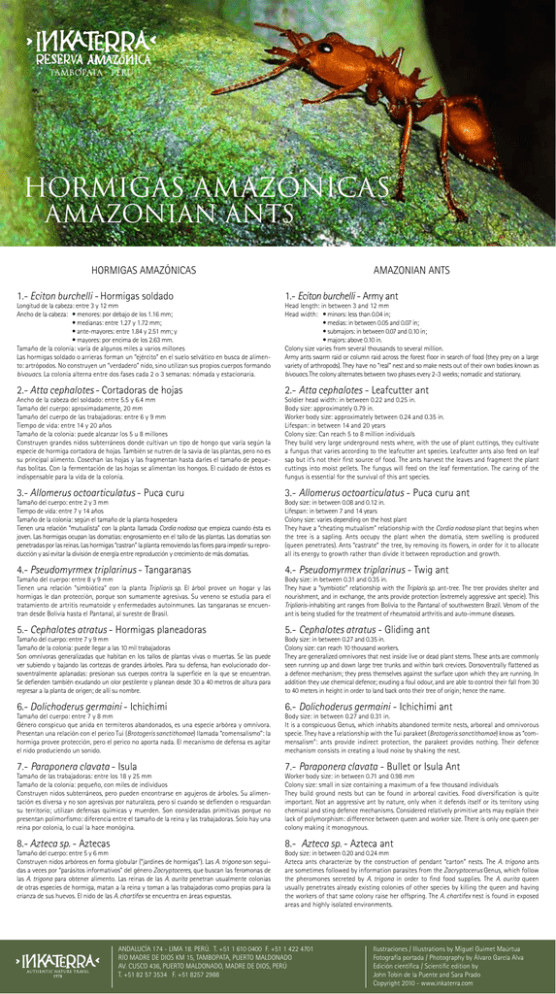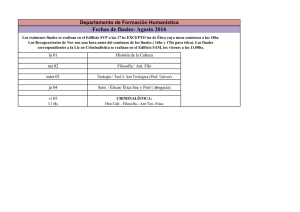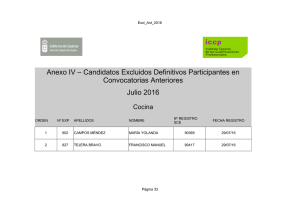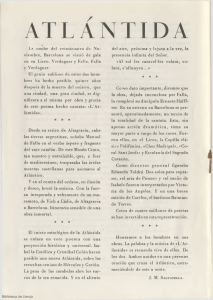HORMIGAS amazónicas
Anuncio

HORMIGAS amazónicas amazonian ANTS HORMIGAS AMAZÓNICAS Amazonian ants 1.- Eciton burchelli - Hormigas soldado 1.- Eciton burchelli - Army ant 2.- Atta cephalotes - Cortadoras de hojas 2.- Atta cephalotes - Leafcutter ant 3.- Allomerus octoarticulatus - Puca curu 3.- Allomerus octoarticulatus - Puca curu ant Longitud de la cabeza: entre 3 y 12 mm Ancho de la cabeza: • menores: por debajo de los 1.16 mm; • medianas: entre 1.27 y 1.72 mm; • ante-mayores: entre 1.84 y 2.51 mm; y • mayores: por encima de los 2.63 mm. Tamaño de la colonia: varía de algunos miles a varios millones Las hormigas soldado o arrieras forman un “ejército” en el suelo selvático en busca de alimento: artrópodos. No construyen un “verdadero” nido, sino utilizan sus propios cuerpos formando bivouacs. La colonia alterna entre dos fases cada 2 o 3 semanas: nómada y estacionaria. Ancho de la cabeza del soldado: entre 5.5 y 6.4 mm Tamaño del cuerpo: aproximadamente, 20 mm Tamaño del cuerpo de las trabajadoras: entre 6 y 9 mm Tiempo de vida: entre 14 y 20 años Tamaño de la colonia: puede alcanzar los 5 u 8 millones Construyen grandes nidos subterráneos donde cultivan un tipo de hongo que varía según la especie de hormiga cortadora de hojas. También se nutren de la savia de las plantas, pero no es su principal alimento. Cosechan las hojas y las fragmentan hasta darles el tamaño de pequeñas bolitas. Con la fermentación de las hojas se alimentan los hongos. El cuidado de éstos es indispensable para la vida de la colonia. Tamaño del cuerpo: entre 2 y 3 mm Tiempo de vida: entre 7 y 14 años Tamaño de la colonia: según el tamaño de la planta hospedera Tienen una relación “mutualista” con la planta llamada Cordia nodosa que empieza cuando ésta es joven. Las hormigas ocupan las domatias: engrosamiento en el tallo de las plantas. Las domatias son penetradas por las reinas. Las hormigas “castran” la planta removiendo las flores para impedir su reproducción y así evitar la división de energía entre reproducción y crecimiento de más domatias. 4.- Pseudomyrmex triplarinus - Tangaranas Head length: in between 3 and 12 mm Head width: • minors: less than 0.04 in; • medias: in between 0.05 and 0.07 in; • submajors: in between 0.07 and 0.10 in; • majors: above 0.10 in. Colony size varies from several thousands to several million. Army ants swarm raid or column raid across the forest floor in search of food (they prey on a large variety of arthropods). They have no “real” nest and so make nests out of their own bodies known as bivouacs. The colony alternates between two phases every 2-3 weeks; nomadic and stationary. Soldier head width: in between 0.22 and 0.25 in. Body size: approximately 0.79 in. Worker body size: approximately between 0.24 and 0.35 in. Lifespan: in between 14 and 20 years Colony size: Can reach 5 to 8 million individuals They build very large underground nests where, with the use of plant cuttings, they cultivate a fungus that varies according to the leafcutter ant species. Leafcutter ants also feed on leaf sap but it’s not their first source of food. The ants harvest the leaves and fragment the plant cuttings into moist pellets. The fungus will feed on the leaf fermentation. The caring of the fungus is essential for the survival of this ant species. Body size: in between 0.08 and 0.12 in. Lifespan: in between 7 and 14 years Colony size: varies depending on the host plant They have a “cheating mutualism” relationship with the Cordia nodosa plant that begins when the tree is a sapling. Ants occupy the plant when the domatia, stem swelling is produced (queen penetrates). Ants “castrate” the tree, by removing its flowers, in order for it to allocate all its energy to growth rather than divide it between reproduction and growth. 4.- Pseudomyrmex triplarinus - Twig ant Tamaño del cuerpo: entre 8 y 9 mm Tienen una relación “simbiótica” con la planta Tripliaris sp. El árbol provee un hogar y las hormigas le dan protección, porque son sumamente agresivas. Su veneno se estudia para el tratamiento de artritis reumatoide y enfermedades autoinmunes. Las tangaranas se encuentran desde Bolivia hasta el Pantanal, al sureste de Brasil. Body size: in between 0.31 and 0.35 in. They have a “symbiotic” relationship with the Triplaris sp. ant-tree. The tree provides shelter and nourishment, and in exchange, the ants provide protection (extremely aggressive ant specie). This Tripliaris-inhabiting ant ranges from Bolivia to the Pantanal of southwestern Brazil. Venom of the ant is being studied for the treatment of rheumatoid arthritis and auto-immune diseases. 5.- Cephalotes atratus - Hormigas planeadoras 5.- Cephalotes atratus - Gliding ant 6.- Dolichoderus germaini - Ichichimi 6.- Dolichoderus germaini - Ichichimi ant 7.- Paraponera clavata - Isula 7.- Paraponera clavata - Bullet or Isula Ant 8.- Azteca sp. - Aztecas 8.- Azteca sp. - Azteca ant Tamaño del cuerpo: entre 7 y 9 mm Tamaño de la colonia: puede llegar a las 10 mil trabajadoras Son omnívoras generalizadas que habitan en los tallos de plantas vivas o muertas. Se las puede ver subiendo y bajando las cortezas de grandes árboles. Para su defensa, han evolucionado dorsoventralmente aplanadas: presionan sus cuerpos contra la superficie en la que se encuentran. Se defienden también exudando un olor pestilente y planean desde 30 a 40 metros de altura para regresar a la planta de origen; de allí su nombre. Tamaño del cuerpo: entre 7 y 8 mm Género conspicuo que anida en termiteros abandonados, es una especie arbórea y omnívora. Presentan una relación con el perico Tui (Brotogeris sanctithomae) llamada “comensalismo”: la hormiga provee protección, pero el perico no aporta nada. El mecanismo de defensa es agitar el nido produciendo un sonido. Tamaño de las trabajadoras: entre los 18 y 25 mm Tamaño de la colonia: pequeño, con miles de individuos Construyen nidos subterráneos, pero pueden encontrarse en agujeros de árboles. Su alimentación es diversa y no son agresivas por naturaleza, pero sí cuando se defienden o resguardan su territorio; utilizan defensas químicas y muerden. Son consideradas primitivas porque no presentan polimorfismo: diferencia entre el tamaño de la reina y las trabajadoras. Solo hay una reina por colonia, lo cual la hace monógina. Tamaño del cuerpo: entre 5 y 6 mm Construyen nidos arbóreos en forma globular (“jardines de hormigas”). Las A. trigona son seguidas a veces por “parásitos informativos” del género Zacryptoceres, que buscan las feromonas de las A. trigona para obtener alimento. Las reinas de las A. aurita penetran usualmente colonias de otras especies de hormiga, matan a la reina y toman a las trabajadoras como propias para la crianza de sus huevos. El nido de las A. chartifex se encuentra en áreas expuestas. Body size: in between 0.27 and 0.35 in. Colony size: can reach 10 thousand workers. They are generalized omnivores that nest inside live or dead plant stems. These ants are commonly seen running up and down large tree trunks and within bark crevices. Dorsoventrally flattened as a defence mechanism; they press themselves against the surface upon which they are running. In addition they use chemical defence; exuding a foul odour, and are able to control their fall from 30 to 40 meters in height in order to land back onto their tree of origin; hence the name. Body size: in between 0.27 and 0.31 in. It is a conspicuous Genus, which inhabits abandoned termite nests, arboreal and omnivorous specie. They have a relationship with the Tui parakeet (Brotogeris sanctithomae) know as “commensalism”: ants provide indirect protection, the parakeet provides nothing. Their defence mechanism consists in creating a loud noise by shaking the nest. Worker body size: in between 0.71 and 0.98 mm Colony size: small in size containing a maximum of a few thousand individuals They build ground nests but can be found in arboreal cavities. Food diversification is quite important. Not an aggressive ant by nature, only when it defends itself or its territory using chemical and sting defence mechanisms. Considered relatively primitive ants may explain their lack of polymorphism: difference between queen and worker size. There is only one queen per colony making it monogynous. Body size: in between 0.20 and 0.24 mm Azteca ants characterize by the construction of pendant “carton” nests. The A. trigona ants are sometimes followed by information parasites from the Zacryptocerus Genus, which follow the pheromones secreted by A. trigona in order to find food supplies. The A. aurita queen usually penetrates already existing colonies of other species by killing the queen and having the workers of that same colony raise her offspring. The A. chartifex nest is found in exposed areas and highly isolated environments. ANDALUCÍA 174 - LIMA 18. PERÚ. T. +51 1 610 0400 F. +51 1 422 4701 RÍO MADRE DE DIOS KM 15, TAMBOPATA, PUERTO MALDONADO AV. CUSCO 436, PUERTO MALDONADO, MADRE DE DIOS, PERÚ T. +51 82 57 3534 F. +51 8257 2988 Ilustraciones / Illustrations by Miguel Guimet Maúrtua Fotografía portada / Photography by Álvaro García Alva Edición científica / Scientific edition by John Tobin de la Puente and Sara Prado Copyright 2010 - www.inkaterra.com AMAZONIAN ANTS AT INKATERRA RESERVA AMAZONICA 365 species - World Record 1995 Research conducted by John Tobin and Stefan Cover, sponsored by Edward O. Wilson. 1995. 1 Eciton burchelli Hormigas soldado Army Ant 2 Atta cephalotes Cortadoras de hojas Leafcutter Ant 3 Allomerus octoarticulatus Puca curu Puca curu Ant 4 Pseudomyrmex triplarinus Tangaranas Twig Ant 5 Cephalotes atratus Hormigas planeadoras Gliding Ant 6 Dolichoderus germaini Ichichimi Ichichimi Ant 7 Paraponera clavata Isula Bullet or Isula Ant 8 Azteca sp. Azteca Azteca Ant



